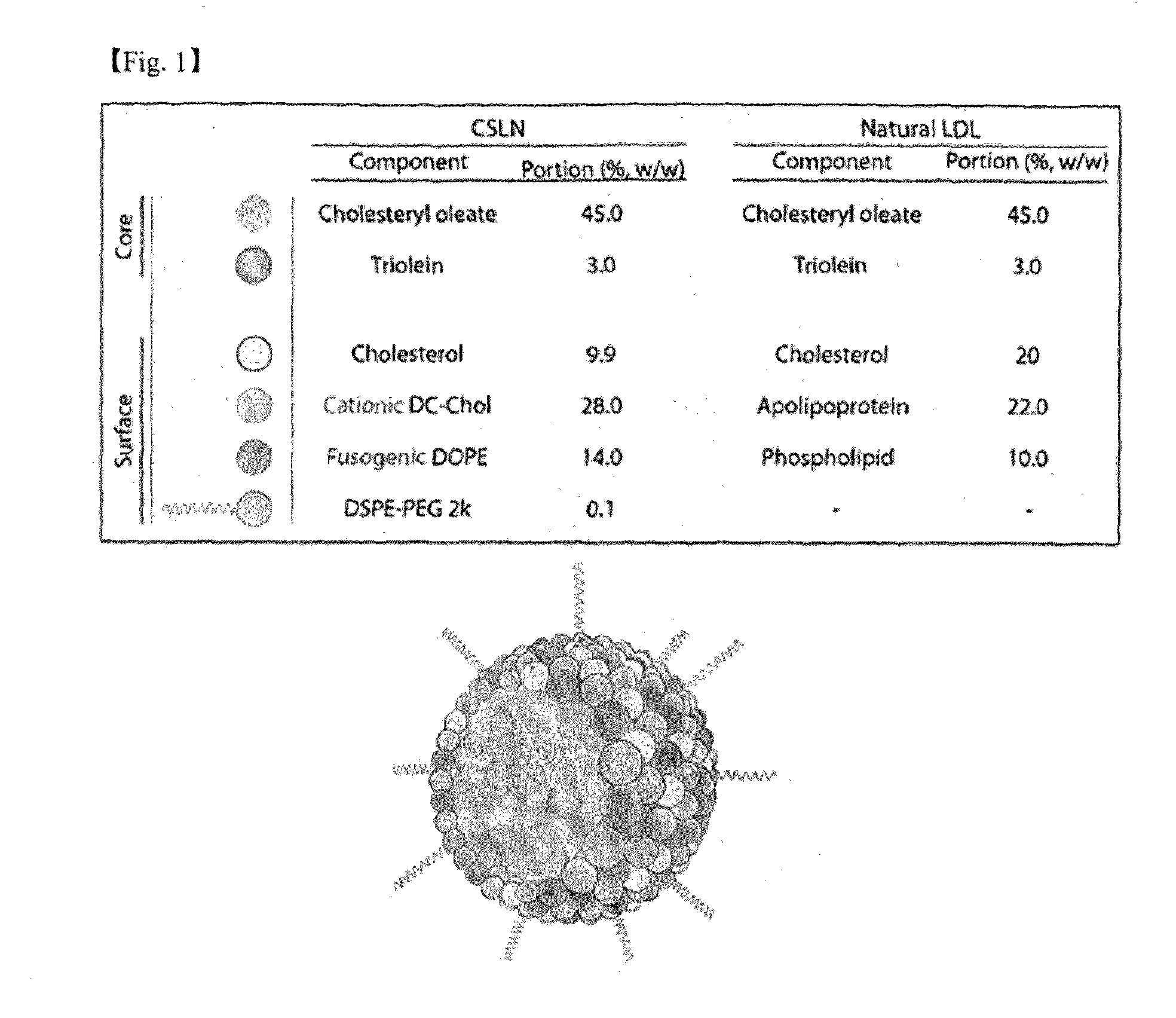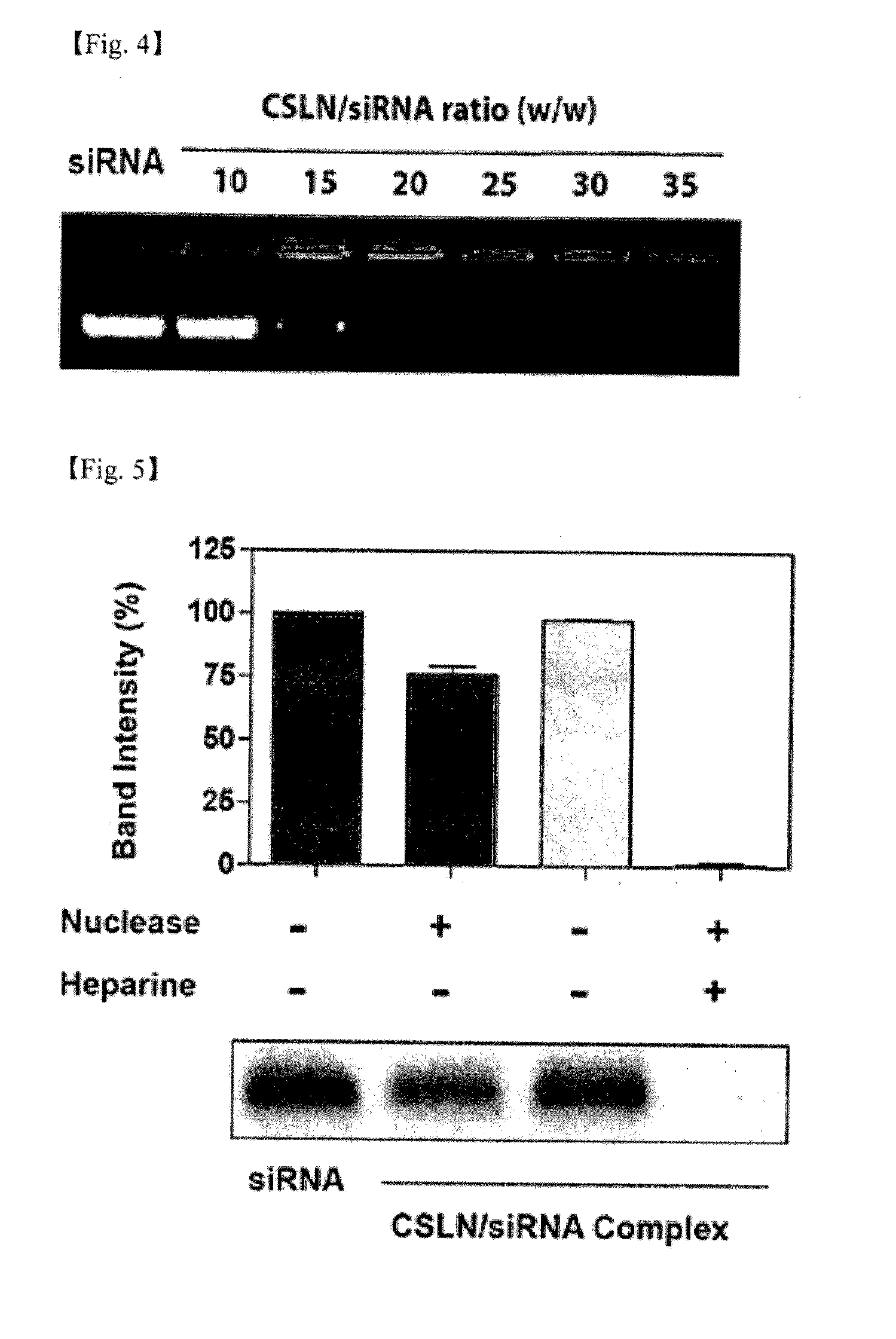Low-density lipoprotein analogue nanoparticles, and composition comprising same for targeted diagnosis and treatment of liver
a technology of low-density lipoproteins and nanoparticles, which is applied in the field of low-density lipoproteinlike cationic solid lipid nanoparticles targeting liver cells, can solve the problems of inability to develop novel drugs, inability to effectively block non-specific elimination, and inability to induce liver tissue damage, etc., to achieve stable nanoparticle-based treatment technology, the effect of preventing non-specific elimination
- Summary
- Abstract
- Description
- Claims
- Application Information
AI Technical Summary
Benefits of technology
Problems solved by technology
Method used
Image
Examples
example 1
Preparation of Low Density Lipoprotein-Like Nanoparticle
[0103]Cationic low density lipoprotein-like nanoparticle (hereinafter CSLN: cationic solid lipid nanoparticle) was prepared using the composition described in the Table below, and the schematic diagram of the nanoparticle comprising the composition and the comparison with the composition of natural low density lipoprotein-like nanoparticle are shown in FIG. 1.
TABLE 2CSLNPortionComponent (%, w / w)Cholesteryl oleate45.0Triolein3.0Cholesterol9.9Cationic DC-Chol28.0Fusogenic DOPE14.0DSPE-PEG 2 k0.1
[0104]The weight ratio of each lipid in the total weight of 50 mg of lipid constituents was 45.0% of cholesteryl oleate, 3.0% of triolein, 9.9% of cholesterol, 28.0% of cationic DC-cholesterol, 14.0% of fusogenic DOPE and 0.1% of DSPE-PEG 2K (1,2-distearoyl-sn-glycero-3-phosphoethanolamine-N-(polyethylene glycol)-2000), and the lipid constituents (50 mg) were dissolved in 2 ml of mixed solvents of chloroform and methanol at 2:1(chloroform:...
example 2
[0105]The CSLN suspension obtained in Example 1 was diluted to the concentration of 1 mg / ml using 0.1 M PBS (pH 7.4). For the obtained diluted suspension, dynamic light scattering was conducted using Malvern Zetasizer Nano ZS apparatus (Malvern, UK), thereby confirming the hydrodynamic size and the zeta potential of CSLN.
[0106]Thereafter, the suspension was mixed with siRNA (Connective tissue growth factor (CTGF) siRNA (siCTGF)) of the weight corresponding to 1 / 30 of the total weight of CSLN included in the diluted suspension, and the mixture was incubated at room temperature for 10 minutes.
siCTGF sense strand(SEQ ID NO: 1)5′-CAAUACCUUCUGCAGGCUGGAdTdT-3′siCTGF antisense strand(SEQ ID NO: 2)5′-UCCAGCCUGCAGAAGGUAUUGdTdT-3′
[0107]For the obtained CSLN / siRNA mixed suspension, dynamic light scattering was conducted by the same method as above to confirm the hydrodynamic size and the zetapotential of CSLN / siRNA complex.
[0108]The obtained results are shown in the fol...
example 3
Analysis of Characteristics of CSLN
[0110]3.1. AFM Analysis
[0111]The CSLN suspension prepared in Example 1 was diluted to the concentration of 0.1 mg / ml using distilled water. 700 μl of the diluted suspension was dropped onto a mica plate of 1 cm×1 cm size. The mica plate onto which the diluted CSLN was dropped was dried in a dessicator for 12 hours. For the dried mica plate, tapping mode AFM analysis was conducted using Multimode SPM apparatus of Veeco Company, to confirm the topology of CSLN. The obtained results are shown in FIG. 2. The FIG. 2 is a height AFM image of the CSLN, and it shows that CSLN forms stable spherical assemblies properly dispersed within a diameter range of 102±2.4 nm on the average.
[0112]3.2. Evaluation of Cytotoxicity of CSLN
[0113]After seeding HepG2 cell line (Korean Cell Line Bank, KCLB No 88065) on a 48-well plate at 2×104 cells / well, it was maintained in MEM culture medium (GIBCO Invitrogen, Carlsbad, Calif.) containing 1% (w / v) antibiotics and 10% (v / v...
PUM
| Property | Measurement | Unit |
|---|---|---|
| mole ratio | aaaaa | aaaaa |
| weight average molecular weight | aaaaa | aaaaa |
| carbon number | aaaaa | aaaaa |
Abstract
Description
Claims
Application Information
 Login to View More
Login to View More - R&D
- Intellectual Property
- Life Sciences
- Materials
- Tech Scout
- Unparalleled Data Quality
- Higher Quality Content
- 60% Fewer Hallucinations
Browse by: Latest US Patents, China's latest patents, Technical Efficacy Thesaurus, Application Domain, Technology Topic, Popular Technical Reports.
© 2025 PatSnap. All rights reserved.Legal|Privacy policy|Modern Slavery Act Transparency Statement|Sitemap|About US| Contact US: help@patsnap.com



